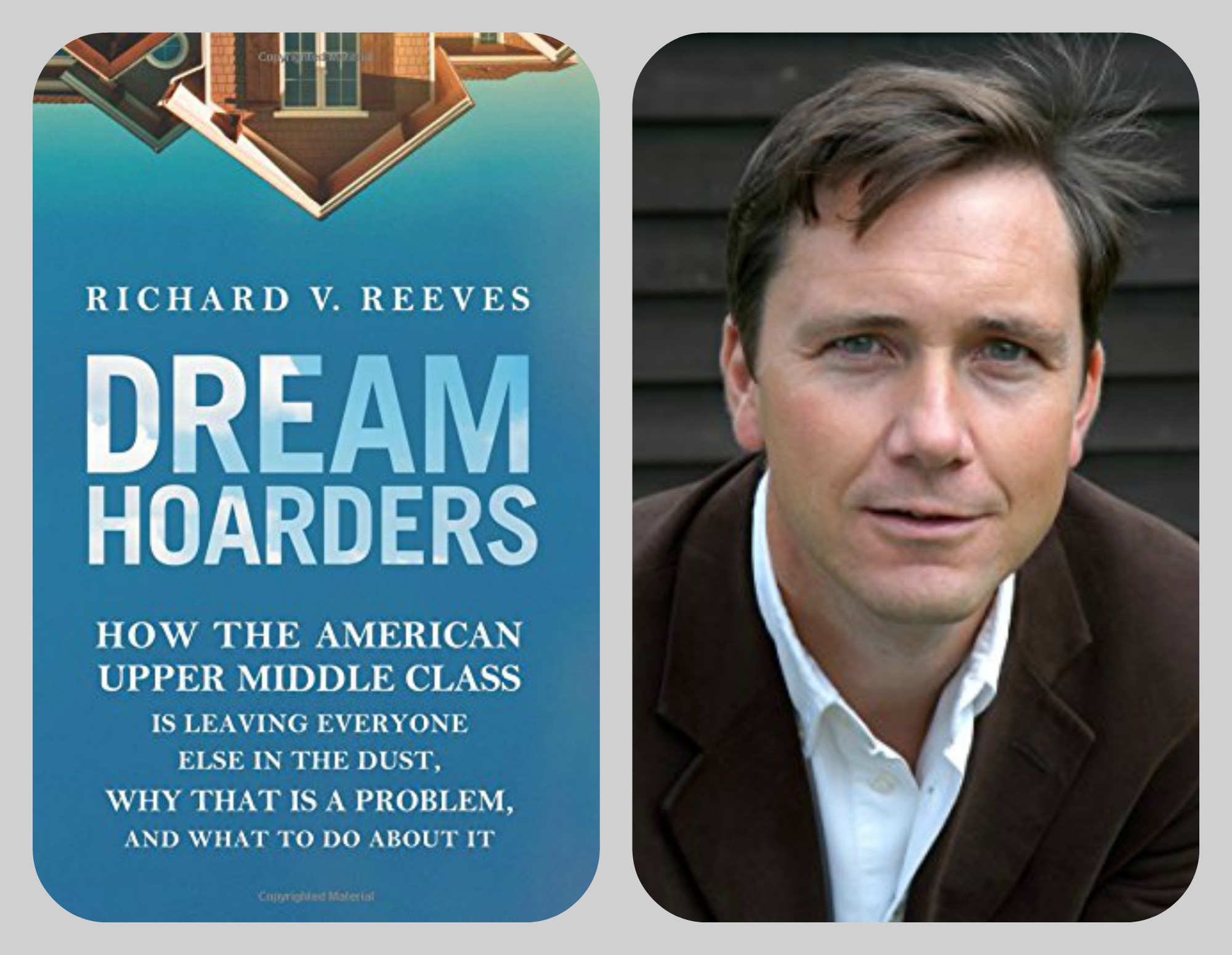Book Review: The Dream Hoarders: How the American Upper Middle Class Is Leaving Everyone Else in the Dust, Why That Is a Problem, and What to Do about It by Richard V. Reeves published by Brookings Institution Press, June 2017
Take the top 20 percent of the American population and remove from it the One Percent, the ultra-rich. What do you get? A new class, roughly the “top” of the middle class, that is changing the way America consumes, thinks, and votes.
That, in a nutshell, is the argument made by several highly respected social scientists, starting with Tyler Cowen, who was the first out with his book, The Complacent Class in February 2017. Unsurprisingly, it was an instant bestseller, he is a respected economist with a popular blog. Next out in May was Elizabeth Currid-Halkett’s excellent, Veblen-inspired The Sum of Small things (reviewed on Impakter), followed in June by two more notable books, Richard Reeves’ The Dream Hoarders and Edward Luce’s The Retreat of Western Liberalism – though the latter has a broader scope, analyzing not just the upper middle class, but the whole system.
When it comes to describing this new class, details are different in each book, but what is remarkable is that all four authors are of one voice to condemn this new class.
For Edward Luce, an Oxford-educated journalist, this new class is “tone deaf” to the demands of the rest of the middle class, particularly the “white trash” left behind by globalization. For Tyler Cowen, it is “complacent” and static, ensconced in self-contentment, unaware of a coming revolution. For Elizabeth Currid-Halkett, it is “pernicious” in wanting (and achieving) self-perpetuation. Richard Reeves agrees with her and views it as incredibly self-centered, “leaving everyone else in the dust”.
I’d like to spend some time here reviewing Reeves’ book because it is the most propositional of the lot, suggesting how, with some simple political measures, the “American Dream”, now badly damaged, could be restored and made to work for the whole of society.
 PHOTO CREDIT: Flickr – Adrian
PHOTO CREDIT: Flickr – Adrian
The Social Impact of Income Inequality
The centerpiece of Reeves’ argument is this:
“Postsecondary education in particular has become an “inequality machine.” As more ordinary people have earned college degrees, upper middle-class families have simply upped the ante. Postgraduate qualifications are now the key to maintaining upper middle-class status. The upper middle class gains most of its status not by exploiting others but by exploiting its own skills.”
He sees this process as resulting in class stratification. The danger is that it “may blunt market dynamism by reducing the upward flow of talent and leaving human capital underutilized among the less fortunate.”
In short, it is a barrier to what Vilfredo Pareto famously called “the circulation of the elites” that keeps the door of opportunity open to anyone with talent. The “American Dream” is another way of saying this – the possibility that with hard work, anyone can “make it” in America. Pareto demonstrated that this was fundamental to maintaining a healthy society, and Reeves – while never mentioning Pareto – is out to prove the same thing in his book.
 PHOTO CREDIT: Flickr
PHOTO CREDIT: Flickr
In my view, he succeeds very well and his conclusion is dire: “Right now we have meritocracy without mobility.” Yet, despite the convincing arguments he puts forward, one key piece is wrong. He assumes that “relative inter-generational mobility is necessarily a zero-sum game. For one person to move up the ladder, somebody else must move down.”
Not so. If it were true, then it would mean that the economy is static, that the middle class’s economic pie neither grows, nor shrinks. In actual fact, it moves in both directions, the bottom is fraying into poverty, and the top expanding into the upper 20 percent. How it will balance out in the end is not clear yet, but the thing is, it never stays put. It’s never a zero-sum game.
But he is right about one thing:
“It’s true that the top 1% are pulling away even faster, but they are a constantly changing group with a lot of circulation in and out of it. On terms of their effect, the top 1% aren’t really a big enough group to have much of an effect.”
The catch, he says, is that the upper middle class is able to point to the 1% as the problem: ‘It’s those rich bastards up there.’” But that of course is “empirically wrong, because it’s not where the inequality is, and morally wrong because the upper 20% have actually been doing pretty well,” which is what he amply documents in his book. The “inequality problem does not kick in at 99%” but much below that in the income ladder.
 PHOTO CREDIT: Pexels
PHOTO CREDIT: Pexels
Barriers to Upward Mobility
The barriers are subtle and many. A major one Reeves points to are city zoning laws. Enacted in a pre-civil rights time to sustain racist apartheid, they now serve “class segregation”.
Also, American universities are openly preferential, favoring “legacy” students. When Reeves discovered this, he was astonished. He brings to his analysis of American society his knowledge of European class distinctions – he’s a British citizen who has recently acquired American citizenship in 2016 (he had moved to America in 2012). The “legacy student” status, a consequence of past attempts to keep out Jews from Ivy League colleges, is a gate-keeping gizmo that now works “very well for class segregation”. Of course, this is right as far as it goes, though, as far as I know, the “legacy students” barrier was not particularly designed against the Jews: for example, Columbia University, which has a strong Jewish community, uses the system exactly like every other big, historic university in America.
“Preferential internships” are, in his view, another barrier. He criticizes billionaire Bloomberg for doing just that, awarding preferential internships when he was Mayor of New York:
“Of the 1,500 interns hired during Bloomberg’s three-term administration, one in five had been recommended by someone within the administration. Such practices, he writes, undermine claims of a meritocratic society. ‘In some ways, the myth of United States as a classless society is getting in the way’. “(italics added)
One in five does not seem so bad.
Also, what does the word “recommendation” mean in this context? Without the “right profile”, recommendations in a fair society will get you absolutely nowhere. They only work in corrupt societies (like, for example, Italy).
The real question is: Did Bloomberg promote to internship positions people that did not deserve to be promoted?
This aspect is something Reeves does not address in his book (understandably so, the evidence would be hard to unearth).
 PHOTO CREDIT: Flickr
PHOTO CREDIT: Flickr
Also, the other interesting aspect about this particular story is this: Reeves’ argument can be reversed.
First, let’s note that Bloomberg does not belong to the upper middle class identified by Reeves. He belongs to the One Percent. Yet, through preferential access to the New York City internship program, he has helped promote youths that presumably came from the whole of the middle class, not just the top 20 percent.
If so, and contrary to Reeves’ argument, this does not lead to greater inequality but more equality: the One Percent is giving a hand to those who deserve to be promoted, no matter where they sit on the economic ladder.
Remember the stats: Four in five of the NYC interns did not get in on the basis of a recommendation: They made it on their own merit. Which suggests that internships such as this one are not restricted to the 20 percent. They are in fact open to the whole range of the middle class. In short, sustaining the circulation of the elites.
Reeves however makes a sound argument when he writes that the “myth that the US is a classless society” actually “stands in the way” of doing anything constructive, by way of policy reform and other measures, to correct the situation. That’s why academia has focused on the question recently and so many books have been written about it.
There is little question that this wave of interest has been further spurred by the controversies Trump has unleashed when he gave family members excessive power in the White House and filled his cabinet with billionaires. “One of the silver linings of Trump’s victory is some introspection among the upper middle class,” Reeves told the UK Guardian (Note: Reeves is a former UK Guardian journalist). “There’s a growing willingness to accept that some advantages are not the result of purely meritocratic society and are the result of a rigged system and people have a right to be angry. It’s a difficult conversation but until we have it, there’s no chance of a solution.”
 PHOTO CREDIT: Flickr
PHOTO CREDIT: Flickr
There is certainly such a conversation now going on and that’s a good thing. Yet I don’t see what is so wrong with the top 20 percent, what is so pernicious or bad about caring for one’s children’s future. And, as I have argued in a previous article, the very patterns of consumption adopted by what Elizabeth Currid-Halkett calls the “aspirational class” have a knock-on positive effect.
Actually, the 20 percent is having a substantial impact on modern society. Because of them, new markets open up for new products: For fair-trade goods, artisanal products, traditional artifacts and a whole series of sustainable products that are seen by aspirational class members as absolutely necessary to preserve the environment and mankind’s continued existence on this planet.
These are high values that should be commended and supported, particularly as they create new markets and have a positive economic fallout.
And as the middle class expands in emerging economies, especially China and India, this positive knock-on effect of market creation is likely to get ever larger and more powerful. By 2030, in little over a decade, more than half of the world population will belong to the middle class – that’s over 4 billion, and twenty percent of that is the stunning figure of 800 million.
 PHOTO CREDIT: Pexels
PHOTO CREDIT: Pexels
Reeves’ Solutions to Revive the American Dream
Yet, if Reeves is right in his analysis, this new class could be a threat to the “circulation of the elites” to the extent that it hogs the good jobs and closes the doors to university education to those who can’t afford it.
So what should be done? According to Reeves, the following three steps are urgently needed in the United States:
- equalize human capital development by “reducing unintended pregnancy rates by expanding access to better contraception; narrowing the parenting gap by investing in home visiting; paying the best teachers to work in poorer schools; and making college funding more equal”;
- curb exclusionary zoning through fairer local land use regulation;
- widen the doors into post-secondary education and better jobs through abolition of legacy admissions and opening up internships.
Indeed, these are practical “solutions” and all they require is political will. A “change of heart”, a willingness to hold up a mirror and see what’s wrong. And, of course, there’s the rub. How can such measures be taken in Trump’s America?
Reeves’ answer? He reminds us that it has “become a staple of politicians to declare the American dream dying or dead.” But as he rightly says, “it is not dead. It is alive and well; but it is being hoarded by those of us in the upper middle class. The question is: Will we share it?”
I believe that the American dream can be shared: the dream is embedded in the value system of the aspirational class. The seed has been planted: this is a class that is not comfortable with privilege. Their moral compass does not allow it. Once the Trump Age of narcissism, nepotism and clientelism is over, we can look forward to a fairer America.
 PHOTO CREDIT: Flickr
PHOTO CREDIT: Flickr
Yet More is Needed
In my view, it won’t be enough to fix the problem at the borderline between the top 20 percent and the middle class below. Much more is needed.
Opening the doors to higher education can only be achieved if access to higher education is universally free or nearly-free, as it is in (most) of Europe. The weight of student loans is unbearable; young Americans deserve a better, fairer treatment, like their counterparts in Europe are getting.
The development of human capital requires bigger efforts than what Reeves suggests and needs to start with a whole series of measures to shore up the fraying of the bottom middle class that is threatened with poverty. Specific and practical financial solutions do exist to solve the problems of financial insecurity and intermittent poverty, as sociologists Jonathan Morduch and Rachel Schneider have powerfully suggested in their recently published Financial Diaries: How American Families Cope in a World of Uncertainty.
Again, it’s a matter of political will.
The overall objective should be to restore the fundamentals in society and remove the strangleholds at both ends of the middle class, the bottom, and the top. Only then can the “circulation of the elites” be secured. Until that happens, American society will continue to suffer.
 PHOTO CREDIT: Flickr
PHOTO CREDIT: Flickr
RELATED ARTICLE: A NEW CLASS IS BORN Book Review: The Sum of Small Things: A Theory of the Aspirational Class by Elizabeth Currid-Halkett
EDITOR’S NOTE: THE OPINIONS EXPRESSED HERE BY IMPAKTER.COM COLUMNISTS ARE THEIR OWN, NOT THOSE OF IMPAKTER.COM
FEATURED PHOTO CREDIT: Pexels




 PHOTO CREDIT: Flickr – Adrian
PHOTO CREDIT: Flickr – Adrian PHOTO CREDIT: Flickr
PHOTO CREDIT: Flickr PHOTO CREDIT: Pexels
PHOTO CREDIT: Pexels PHOTO CREDIT: Flickr
PHOTO CREDIT: Flickr PHOTO CREDIT: Flickr
PHOTO CREDIT: Flickr PHOTO CREDIT: Pexels
PHOTO CREDIT: Pexels PHOTO CREDIT: Flickr
PHOTO CREDIT: Flickr PHOTO CREDIT: Flickr
PHOTO CREDIT: Flickr






